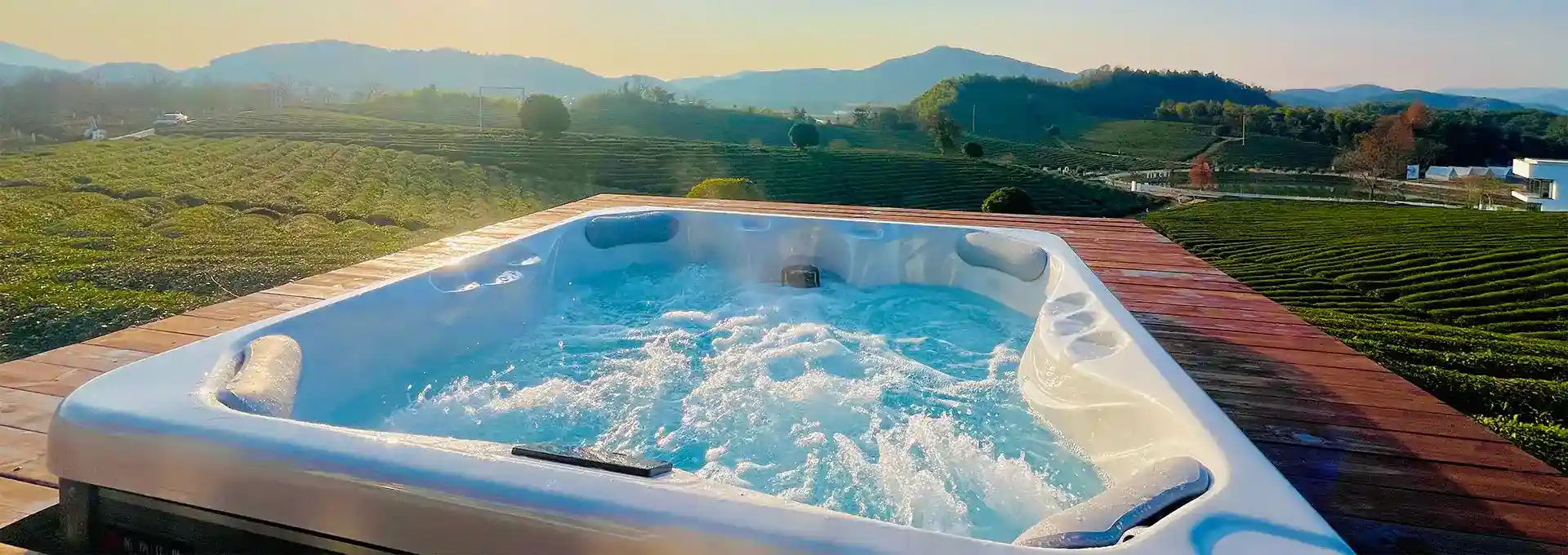Can You Winterize a Swim Spa?
2024-10-14 09:41:44
Swim spas have become increasingly popular for their versatility, offering the benefits of both a swimming pool and a hot tub in a compact package. As the temperatures drop and winter approaches, many swim spa owners wonder if they need to winterize their beloved aquatic retreat. The good news is that swim spas, including 7-person models, can indeed be winterized to protect them from harsh winter conditions and ensure they're ready for use when warmer weather returns.
Winterizing a 7-person swim spa involves a series of steps to prevent damage from freezing temperatures and to maintain the spa's components during periods of disuse. This process is especially important for those who live in regions with severe winters or for those who plan to leave their swim spa unused for extended periods. By properly winterizing your swim spa, you can protect your investment and avoid costly repairs come spring.
Let's explore some common questions about winterizing 7-person swim spas and provide detailed answers to help you maintain your aquatic oasis throughout the colder months.
How do you maintain a 7-person swim spa in winter?
Maintaining a 7-person swim spa during winter requires a combination of regular care and preventive measures. Even if you plan to use your swim spa throughout the colder months, it's essential to adjust your maintenance routine to account for the challenges that winter brings.
First and foremost, it's crucial to keep your swim spa covered when not in use. A high-quality, well-fitted cover helps retain heat, reduces energy costs, and prevents debris from entering the water. Make sure your cover is in good condition, with no tears or damage that could compromise its insulation properties. Some swim spa owners opt for additional floating thermal blankets to provide an extra layer of insulation beneath the main cover.
Water chemistry becomes even more critical during winter. Cold temperatures can affect the balance of chemicals in your swim spa, so it's important to test the water more frequently – ideally, two to three times a week. Pay close attention to pH levels, sanitizer levels (chlorine or bromine), and alkalinity. Adjust these parameters as needed to keep the water clean and clear. Remember that even though it's cold outside, bacteria can still thrive in the warm waters of your swim spa.
Maintaining proper water levels is another key aspect of winter care. If the water level drops too low, it can expose the heating elements and pumps, potentially causing damage. Check the water level regularly and top it off as needed, being mindful not to overfill, as this can lead to freezing and expansion issues.
Your swim spa's filtration system plays a crucial role in keeping the water clean and circulating. During winter, it's important to clean or replace filters more frequently, as they may accumulate more debris due to winter storms or falling leaves. A clean filter ensures efficient water circulation, which is essential for preventing freezing and maintaining water quality.
Speaking of circulation, it's vital to keep your swim spa running throughout the winter, even if you're not using it regularly. Most modern swim spas have freeze protection systems that automatically activate pumps and heaters when temperatures drop dangerously low. However, it's a good idea to manually run the jets for a few minutes each day to ensure all pipes and components are circulating warm water.
Pay attention to the area around your swim spa as well. Keep the surrounding deck or patio clear of snow and ice to prevent accidents and make access to the spa safer and more convenient. If you have steps leading to your swim spa, consider adding non-slip mats or treads for additional safety during icy conditions.
Lastly, don't forget about the cabinet of your swim spa. Inspect it regularly for any signs of damage or wear that could allow cold air to penetrate. If you notice any issues, address them promptly to maintain the spa's energy efficiency and protect its internal components.
By following these maintenance tips, you can ensure that your 7-person swim spa remains a warm and inviting retreat throughout the winter months, ready for you to enjoy a relaxing soak or invigorating swim regardless of the weather outside.
What temperature should a swim spa be in winter?
The ideal temperature for a swim spa in winter depends on how you plan to use it. If you intend to continue swimming or exercising in your swim spa during the colder months, you'll want to maintain a temperature that's comfortable for physical activity while also being energy-efficient.
For active use, many swim spa owners find that a temperature between 80°F and 85°F (26.7°C to 29.4°C) is ideal. This range provides a refreshing environment for swimming and aquatic exercises without being too cold or causing excessive heat loss from the body. It's important to note that everyone's comfort level is different, so you may need to experiment to find the perfect temperature for your needs.
If you primarily use your swim spa for relaxation and hydrotherapy during winter, you might prefer a higher temperature. In this case, setting the temperature between 98°F and 104°F (36.7°C to 40°C) can create a soothing, spa-like experience. This higher temperature range is particularly enjoyable when the air outside is cold, providing a stark and pleasurable contrast.
However, it's crucial to consider energy efficiency when setting your swim spa's temperature in winter. Higher temperatures require more energy to maintain, which can lead to increased utility bills. If you're not using your swim spa regularly, consider lowering the temperature to around 95°F (35°C) when it's not in use. This temperature is high enough to prevent freezing while still being energy-efficient.
Many modern swim spas come equipped with programmable thermostats that allow you to set different temperatures for different times of the day or week. This feature can be particularly useful in winter, as you can program the spa to warm up before your planned use and cool down during periods of inactivity.
It's also worth noting that the ambient air temperature can affect how quickly your swim spa loses heat. In regions with extremely cold winters, you might need to set your swim spa's temperature slightly higher to compensate for heat loss. Additionally, using a well-insulated cover and thermal blankets can help maintain your desired temperature more efficiently.
When adjusting your swim spa's temperature, it's important to make changes gradually. Rapid temperature fluctuations can stress the spa's components and affect water chemistry. Aim to change the temperature by no more than 1-2 degrees per hour.
Can you use a swim spa all year round?
The short answer is yes, you can absolutely use a 7-person swim spa all year round! In fact, one of the greatest advantages of owning a swim spa, especially a 7-person model, is its versatility and ability to provide enjoyment regardless of the season. Unlike traditional outdoor pools, which often become unusable during colder months, swim spas are designed to operate efficiently in various weather conditions, making them a perfect choice for year-round use.
During the warmer months, a swim spa offers a refreshing retreat from the heat. You can enjoy swimming, aquatic exercises, or simply lounging in the cool water. The compact size of a swim spa means it's easier to maintain and keep clean compared to a full-sized pool, making it a low-maintenance option for summer recreation.
As the temperatures begin to drop in fall, many people find that their swim spa becomes even more inviting. The warm water provides a stark and pleasant contrast to the crisp air, creating a unique and enjoyable experience. It's not uncommon for swim spa owners to find themselves using their spa more frequently during these transitional seasons.
Winter use of a swim spa can be particularly rewarding. Imagine stepping into warm, soothing water while snowflakes gently fall around you – it's an almost magical experience that many swim spa owners cherish. The heated water and powerful jets can provide relief from winter aches and pains, making it an excellent option for hydrotherapy during the colder months.
However, year-round use of a swim spa does require some considerations and preparations:
1. Insulation: Ensure your swim spa is well-insulated to maintain water temperature efficiently. This includes a high-quality, well-fitted cover and potentially additional insulation around the cabinet.
2. Energy Efficiency: Be prepared for potentially higher energy bills during colder months as your swim spa works harder to maintain temperature. Using energy-efficient settings and covers can help mitigate these costs.
3. Water Chemistry: Year-round use means year-round maintenance. Be diligent about checking and balancing your water chemistry regularly, as usage patterns and environmental factors can affect water quality.
4. Safety: Create safe pathways to and from your swim spa, especially during winter when surfaces can become slippery. Consider installing non-slip mats or heated walkways for added safety.
5. Maintenance Schedule: Adjust your maintenance routine according to the seasons. For example, you might need to clean filters more frequently during fall when leaves are falling.
6. Temperature Management: As discussed earlier, adjust your swim spa's temperature based on your usage and the season. Lower temperatures for active use, higher for relaxation, and somewhere in between for energy efficiency when not in use.
7. Weather Protection: In areas with extreme weather, consider additional protection for your swim spa, such as a gazebo or enclosure. This can enhance your year-round enjoyment and protect the spa from harsh elements.
By taking these factors into account, you can maximize your enjoyment of your 7-person swim spa throughout the year. Whether you're looking for a vigorous swim in the height of summer, a soothing soak on a chilly autumn evening, or a warm retreat in the depths of winter, your swim spa can accommodate your needs.
Year-round use also maximizes the value of your investment. Instead of a seasonal amenity, your swim spa becomes a constant source of recreation, relaxation, and wellness. Many swim spa owners find that having access to their spa 365 days a year enhances their quality of life, providing opportunities for exercise, stress relief, and social gatherings regardless of the weather outside.
In conclusion, a swim spa, particularly a spacious 7-person model, is indeed a year-round asset. With proper care, maintenance, and a little creativity, you can transform your swim spa into an all-season oasis that provides endless enjoyment, regardless of what the calendar or thermometer says. So go ahead, take the plunge, and experience the joy of year-round swim spa use!
For more information on hot tub installations and to find out more about our products, please feel free to contact us at info@iparnassus.com.
References:
1. Swim University. (2024). "How to Winterize an Above Ground Pool or Inground Pool."
2. Hot Spring Spas. (2023). "Winter Hot Tub Maintenance Tips."
3. Endless Pools. (2024). "Year-Round Swimming: The Benefits of Indoor Pools."
4. Aqua Magazine. (2022). "Winterizing Pools and Spas: A Comprehensive Guide."
5. Pool Research. (2023). "Maintaining Your Pool in Cold Weather."
6. Swim Spa Source. (2024). "Swim Spa Temperature Guide: Finding the Perfect Balance."
7. Master Spas. (2023). "Using Your Swim Spa in Winter: Tips and Tricks."
8. Bullfrog Spas. (2024). "Energy Efficiency in Hot Tubs and Swim Spas."
9. Aqua-Tech. (2023). "Year-Round Pool and Spa Maintenance Schedule."
10. Hayward Pool Products. (2024). "Winterizing Your Pool Equipment: Best Practices."



